Construction
Essential liability endorsements contractors may need to meet project requirements and protect their business.
Note: This checklist is a general guide. Specific contracts and project types may require additional or different endorsements. Always review each project’s insurance requirements carefully with a licensed insurance professional.
- Blanket Waiver of Subrogation (By Contract)
What it does: Prevents your insurance carrier from seeking reimbursement from the general contractor, customer, or property owner after paying a claim.
Why it matters: Most contracts require this to avoid disputes between your insurance company and the party that hired you.
- Additional Insured (By Contract)
What it does: Adds the general contractor, property owner, or developer as an insured on your policy for liability arising out of your work.
Why it matters: This protects those parties if they are named in a lawsuit because of something related to your operations.
- CG 20 10 – Additional Insured: Ongoing Operations
What it does: Covers the additional insured while work is actively being performed.
Why it matters: Frequently required in commercial construction contracts to ensure the hiring party is protected during the construction phase.
- CG 20 37 – Additional Insured: Completed Operations
What it does: Extends coverage to the additional insured for claims that occur after the job is finished.
Why it matters: Some liability exposures only emerge after the work is complete. Many contracts require this endorsement for a period following project completion.
- Primary and Non-Contributory Wording
What it does: Ensures your policy responds first in the event of a claim and does not seek contribution from the additional insured’s policy.
Why it matters: This protects your client’s own insurance policy from being used in a loss caused by your work.
- Products and Completed Operations Coverage
What it does: Covers liability for bodily injury or property damage caused by your completed work or products.
Why it matters: This coverage is critical for protecting your business after work is finished and is commonly required in contracts.
- Per Project Aggregate Limit Endorsement
What it does: Provides a separate aggregate liability limit for each project you work on.
Why it matters: Ensures that claims on one project do not reduce the total available limits for other jobs.
- Designated Construction Project(s) General Aggregate Limit
What it does: Ties your general aggregate limit to specific listed projects.
Why it matters: Helps contractors comply with contracts that require distinct limits for specific jobs.
- Residential Construction Exclusion (Tract Homes)
What it does: Some policies exclude work on residential developments or tract homes.
Why it matters: If you work on single-family subdivisions or similar projects, this exclusion could leave you without coverage unless modified or removed.
- 30-Day Notice of Cancellation
What it does: Requires your insurance company to notify the certificate holder (such as a project owner or developer) at least 30 days in advance if your policy is being canceled or non-renewed.
Why it matters: This gives the contracting party time to take action and reduces their exposure if your coverage lapses.
